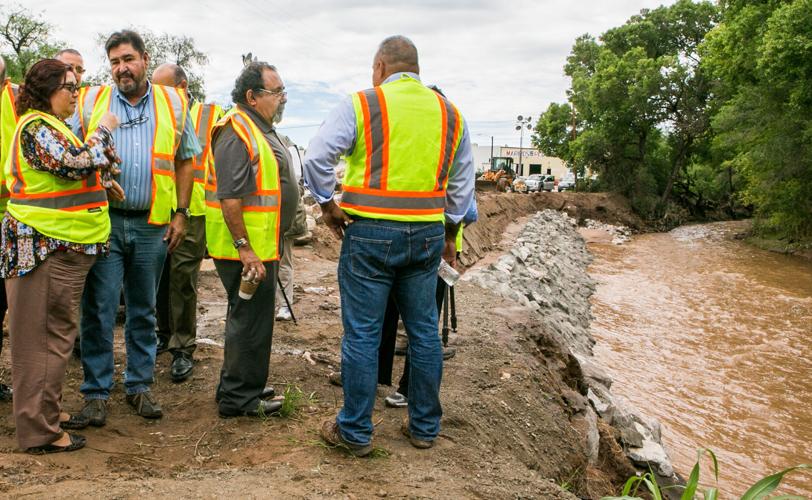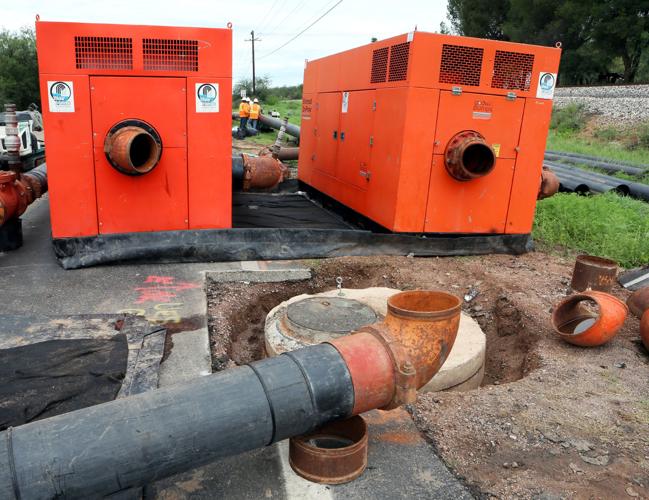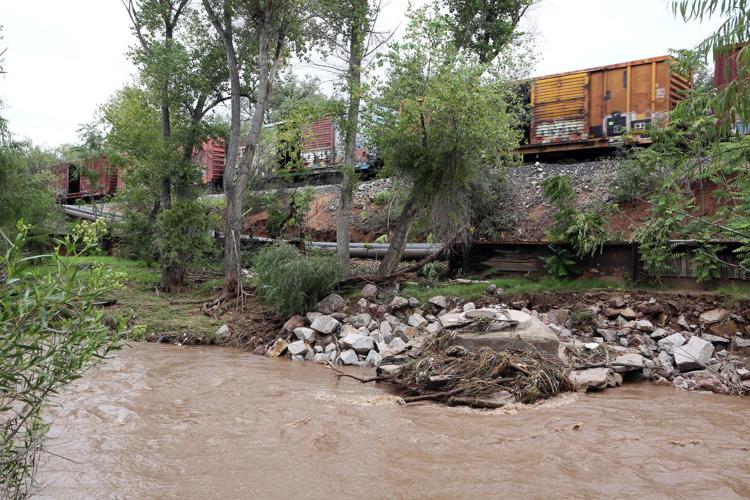It’s a situation residents of the Sonora-Arizona border region are used to: Every summer, heavy monsoons overfill the shallow washes and swell over the banks of the Santa Cruz River. Every summer, gravity pulls the water, full of erosive grit and debris, northward, flooding streets and damaging homes and property. Residents usually wait out the rains, then get on with their lives.
But with those storms arriving earlier and hitting harder, putting extra stress on old pipes that already carry millions of gallons of sewage from south to north, researchers and floodplain specialists say the potential risks for public and environmental health are severe.
“Water and rivers don’t observe political boundaries,” said Margaret Wilder, a professor of geography and development at the University of Arizona who has conducted several studies concerning water security along the U.S.-Mexico border. “Water contamination, air pollution, climate-change risks — these are all things Mexico and the U.S. share.”
Record-breaking rainfall this summer exacerbated longstanding issues with binational sewer systems. In July, the International Outfall Interceptor (IOI), a 46-year old concrete pipe that can carry up to 14 million gallons of raw sewage and runoff a day from Nogales, Sonora and Nogales, Arizona, to a treatment plant in Rio Rico, ruptured under the strain of heavy floods from Mexico, spilling raw sewage into a tributary of the Santa Cruz River and causing a significant spike in E. coli bacteria levels near the breach, government testing showed.
Two months later, a decades-old issue with untreated wastewater flowing from a faulty sewer main in Naco, Sonora, to Naco, Arizona, caught the attention of federal officials after it worsened due to the heavy rains.
Although pressure from alarmed residents is driving the initial steps for repairs, bureaucratic debates over the responsibility of the binational waste systems are hampering a permanent solution to both problems, officials and residents say.
“Now that we have a hazardous, nonstop sewage flood coming into the United States, there’s obviously intermediate concerns about the risks and the mitigation related to health,” said U.S. Rep. Martha McSally of her recent tour of the sewage spill in Naco. Her office, along with the offices of Arizona Sens. John McCain and Jeff Flake, is trying to work out which agencies are responsible for solving the problem.
They have sent letters regarding the sewage spill to both the International Boundary and Water Commission and the Environmental Protection Agency.
“But in the meantime, every day that goes by, there is sewage flowing into private property,” McSally said. “And it’s been going on for way too long.”
Crucial repairs delayed
When the IOI was built in 1971 as part of an international treaty aimed at improving sanitation on both sides of Nogales, designers did not anticipate that four decades later it would be shuttling an average of over 12 million gallons to the treatment plant in Rio Rico, 3 million more than the original allotment. But given the population disparity of the sister cities, that can only be expected: The city of Nogales Sonora, a busy manufacturing hub, grew to 233,952 people by 2015, according to a recent census, while the city of Nogales, Arizona, has a population of 20,008.
“The pipe just is old, and it ruptured,” said Lori Kuczmanski, a spokeswoman for the International Boundary and Water Commission. “Mexico did have some rain, and they are releasing some water out a reservoir, and that also caused the wash to be super full.”
The Mexico cities of Nogales and Hermosillo both declared a state of emergency in July due to destructive flooding from atypically heavy rainfall.
Santa Cruz County and Gov. Doug Ducey also declared a state of emergency this year, citing the pipe breach. In July, some areas in Nogales saw more than 13 inches of rain, compared to the 10 to 13 inches averaged during the entire 110-day monsoon season, the Nogales International reported.
Temo Galindo, the mayor of Nogales, Sonora, said the city is taking steps to mitigate damage from future floods, including the cleaning of polluted streams and washes. The Nogales College of Engineers has also recently implemented a project to construct flood-retention structures in the city.
“Little by little, we’re making changes,” Galindo said. “It’s a process.”
Although water and infrastructure issues in Mexico contribute to the problem in Arizona, responsibility for communicating with the neighboring nation falls to the boundary commission.
Repair and maintenance responsibilities for the pipe are divided between the commission and the city of Nogales — but arguments over who should pay could delay crucial repairs.
“It’s literally and figuratively a mess,” Kuczmanksi said.
Following the rupture of the IOI, the commission hired a contractor under emergency authority to divert the sewage stream, but it was a temporary fix.
According to Kuczmanksi, the state has offered to pay up to 75 percent of the repair costs for the damaged pipeline and manhole near the rupture, which they estimate will cost upwards of $5 million. That would leave the city and the county to share the remaining 25 percent of the expenses, but they “refuse to put up a penny,” she said.
Officials with the city of Nogales did not respond to requests for comment, but have stated in the past that according to an international treaty obligation between the boundary commission and Mexico, the agency is responsible for the repair costs.
While engineers with the commission have drafted a five-phase plan to rehabilitate the entire IOI, they say that moving forward is contingent on a cost-sharing agreement with the city.
Health hazard
In Naco, 94 miles west of Nogales, the rugged desert landscape is spoiled by the stench of raw sewage. Wastewater bubbling up from backed-up manholes in Mexico runs south along the border fence and down into a wash on the Arizona side.
After the heavy monsoon season, John Ladd, a cattle rancher whose family has owned land along the border near Naco for generations, says there is currently more sewage in the wash than there is water in the nearby San Pedro River.
“You never get used to it,” he said. The sewage from Mexico has been a lifelong problem for his family; he recalled warning children away from what came to be known as the “(expletive) ditch.”
“The irony of it is that the U.S. is so political about clean water,” he continued. “But if you get waste coming over from Mexico, they say ‘it’s not our problem.’”
Ladd said that while he and other landowners in the area had contracted agencies over the wastewater multiple times in the past, it wasn’t until the issue came to the attention of McSally that he saw real steps taken toward change.
“I actually toured this myself. ... It’s flowing like a river,” McSally said recently. While testing revealed no immediate contamination risk for Naco residents’ drinking water, if the heavy sewage flow continues it could become a serious health hazard, she said.
“We thought the IBWC’s role is to engage because it’s across the border,” she added. “That’s the whole purpose of their existence.”
The IBWC, however, contends that wastewater management in Mexico is outside its authority or jurisdiction.
“The problem needs to be coordinated with the EPA,” Kuczmanski said. “Sewage flowing into the U.S. is an emergency concern, so out of good will, we went to Mexico and gave them a pump.”
Although the new sewer pump is intended to reduce the backed-up sewage in Mexico, Ladd said he had not yet seen any significant changes in the wastewater flow on his land.
Meanwhile, the EPA has not yet responded to the letter sent by the Arizona representatives regarding the issue.
“While all the bureaucracies are trying to claim who is not responsible, we’ve got sewage flowing into ranchers’ land,” McSally said. “Day after day.”
Storm of vulnerability
And climate change could result in further damage to water infrastructure along the Arizona border, researchers have found.
“The potential risk of public health and environmental health seems really significant,” said Wilder, the UA researcher. “Especially if there are worse monsoons, or storm events that create more flooding or more pressure on the pipes.”
As climate change causes extreme changes in rainfall and temperature in the Southwest, it could also causes heavier and more destructive monsoons, according to a recent study published by the American Meteorological Society. The July 2017 monsoon season could be seen as evidence of this, having drenched Southeast Arizona with a record-breaking 6.80 inches of rain.
People don’t understand what it’s like to live on the border, Ladd said. “But this kind of thing is our reality.”






